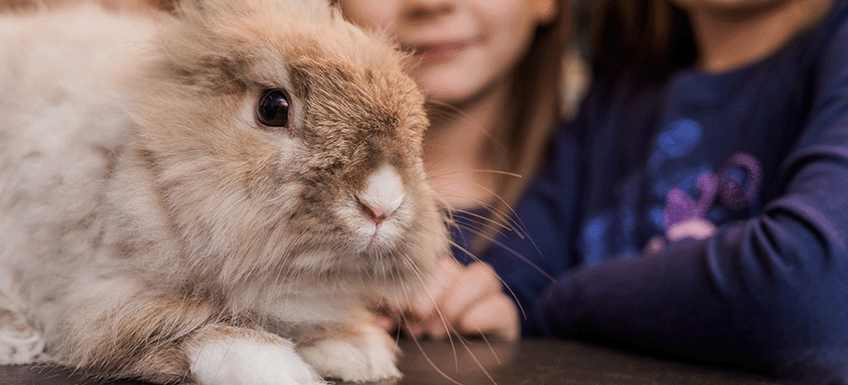
Small Pets for Children
General Advice
Small Animals
Bird
10/05/2023
Guinea pig or mouse, rat or bird, small pets are great for children. They can offer both companionship and entertainment while giving children the opportunity to take on the responsibility of pet ownership. There are a number of small creatures that can make a splendid addition to your family.
Introducing a pet into the family should never be taken lightly because however cute and adorable a small animal may be, it is not a toy and cannot be left for days while a child seeks entertainment elsewhere. Fun should not be overlooked in small-pet partnerships but children need to understand that they are instrumental in maintaining the health and happiness of their pet.
Very young children need to be closely supervised to ensure their own safety and that of their small pet. An animal, whatever its nature, can nip if it’s given a fright. As a grown-up you’ll be able to teach children the safe and correct handling of pets.
Older children will need reminding about their responsibilities, whether they’re sole or shared. Some households use a roster system with one child responsible for feeding and another for cleaning. These duties are rotated on a weekly basis. Younger children will be able to grow into pet-owner duties and you’ll be able to gauge when they can start taking on more responsibility. If you’re cleaning out your pet’s cage, then small children can help as long as you take the precaution of moving the pets to a safe place while you’re doing this.
Another consideration is how well a particular pet will suit your home. A guinea pig or rabbit’s hutch is not ideal in a high-rise apartment, but fish or birds could be considered instead. Many children will have a very firm idea of what sort of pet they’d like. If this is the case, do some careful research on the pet of their choice before you head off to the pet shop or breeder. Ideally, you should set about getting your pet’s house in order before bringing it home.
Is there a definitive age when a child can look after a particular small pet? Age appropriateness is an important consideration when bringing a pet into your home.
Age-appropriate guidelines for Small Pets
| Age | Pet |
|---|---|
| 1-2 years | Fish - Small children love fish gazing. |
| 3-5 years | Can start to learn how to be gentle when holding and handling small animals but need close supervision. Can start to help with cleaning duties but don’t forget hygiene and make sure your pet is in a safe place. |
| 6-8 years | Can handle tamed budgies, can teach mice and rats tricks, feed their pets, and clean out the cages - supervision is recommended. |
| 9+ years | Can care for most small pets independently with less parental support, although reminders will probably be necessary. |
Best Small Pets for Children
Here are some fantastic pets that you might want to consider introducing into your family and their specific requirements. All are fascinating, it’s up to you to choose which one will fit in best:
Rabbits
Handling: Never pick rabbits up by their ears! Hold your rabbit firmly while keeping in mind that this pet has powerful hind legs. Do make sure that your pet will not grow too big for your child to handle.
How Many: A pair of females. A guinea pig makes a good companion for a lone female or neutered male rabbit.
Set-up Costs: Costs vary depending on your chosen breed. These pets need a good-sized hutch or cage and the bigger the better. Hutch prices vary greatly. Like the guinea pig, rabbits need sturdy feeding bowls and a water bottle.
Bedding: Un-tanalised wood shavings, hay or shredded newspaper.
Food: Rabbit pellets supplemented with some fruit, root and green vegetables cut into chunks. These pets also need fresh hay that can be purchased at the pet shop (lucerne or clover).
Lifespan: 6-8 years.
Temperament: Rabbits are sociable pets and the more time your child spends with them, the more friendly and tame they will become. They need lots of stimulation and interaction, as well as time out of their hutch to exercise.
Rats
Handling: Enjoy being handled and can be trained to do tasks such as tightrope walking.
How Many: A same-sexed pair
Set-up Costs: Rats cost from $9.00.
Perspex or glass enclosure - not wood as rats can gnaw through this. The cage needs to be sturdy and draught-free. It should keep your pets in and predators out. Do not overcrowd the cage but rotate safe toys to avoid boredom. Use a water bottle, not a bowl, as rats tend to play in their bowls – bottles from $8.00.
Bedding: Un-tanalised wood shavings or shredded newspaper.
Food: Rat and Mice pellets/feed supplemented with meal scraps. Rodents need a stick or dog biscuit to chew on to keep their teeth in check.
Lifespan: 2-3.5 years.
Temperament: Highly intelligent, loving and very entertaining. Try not to overlook these little pets due to bad press. Don’t house rats with mice as they will eat their smaller cousins.
Mice
Handling: Do not pick it up by its tail but do get to know your pet by hand feeding it.
How Many: Female pair.
Set-up Costs: Mice cost from $3.00 each. _(See Rat Facts) _
Bedding: Un-tanalised wood shavings or shredded newspaper.
Food: Mice pellets/feed supplemented with oats, sunflower seeds, bread soaked in milk, vegetables and hay. As with rats, mice need something safe to gnaw on.
Lifespan: 3-4 years.
Temperament: Adorable, but they have a specific mouse smell.
Guinea Pigs
Handling: Use both hands and be very careful not to drop your pet. Never pick it up by the scruff of its neck.
How Many: Same-sex pair from the same litter, or mother/daughter or father/son. Rabbits also make good companions.
Set-up Costs: Guinea Pigs cost from $10.00 each. These pets need a good-sized hutch or cage. Prices vary quite significantly. Sturdy feeding bowls and a water bottle are hutch essentials.
Bedding: Un-tanalised wood shavings or shredded newspaper.
Food: Guinea Pig pellets (these contain vitamin C, which guinea pigs can’t produce for themselves) can be supplemented with root and green vegetables cut into chunks, as these little pets don’t use their paws for picking up food.
Lifespan: 4-7 years.
Temperament: Also known as Cavies, guinea pigs hail originally from South America. Slower and larger than rats and mice these creatures make ideal first pets for younger children.
Goldfish
Handling: Only handle with a net when cleaning out the aquarium.
How Many: At least two.
Set-up Costs: Goldfish cost from $4.00 each. A rectangular aquarium is preferable to a bowl as there is more surface area. Ensure anything in the aquarium, such as rocks and plants, is placed safely. A net, snails and plants are also necessary for a healthy tank. It is possible to buy a whole set-up from $30.
Water: Ideally, leave water to sit so that the chlorine can dissipate before putting your fish in the tank.
Food: Fish food can be bought from the local pet shop. Be careful not to overfeed your fish.
Lifespan: Some have been known to live over 25 years!
Birds
Handling: Birds can be handled but it is suggested that children under six not handle birds.
How Many: Depends on the bird species you choose.
Set-up Costs: Budgies – from $20.00. Finches – from $7.00. The bigger the cage or aviary the better. Small cages start from $70.00. Birds can suffer from boredom so check out the toys at your pet shop. You can buy a ‘starter kit’ for around $100.00 (excluding the birds).
Food: Food depends on the bird species. Talk to the breeder or pet shop owner to find out the correct diet for your bird. Grit needs to be kept in the cage as part of its diet.
Lifespan: Budgies live from 10-15 years.
General: It is possible to buy hand-tamed budgies. While more expensive, they are ideal for novice bird owners.
Other Considerations
Cost
On-going maintenance and feeding costs for small pets are minimal – around a few dollars a week. Setting yourself up for first pet ownership can be a little more costly. You can buy new or secondhand equipment. If you decide on the latter, make sure it’s safe for your pets and children, and that it meets the needs of the animals. For example, rats and mice should not be housed in cages made of wood because of their ‘gnaw-tiness’. Many pet shops sell ‘starter set-ups’ for some animals, which can prove an economic way forward.
Adopting a small pet can be a great option for families who want to give an animal a second chance at a loving home. Many animal shelters and rescue organisations have small animals available for adoption, including rabbits, guinea pigs, and hamsters. Adoption fees are often lower than purchasing from a pet store or breeder, and by adopting, families can help reduce the number of animals in shelters. Before adopting, it's important to research the specific needs and requirements of the animal and to ensure that the family can provide a suitable home and environment.
Hygiene
Basic hygiene is important both before and after handling a pet. Learning to wash and dry hands effectively is an important life skill. Animal droppings, food and any soiled bedding should be cleaned out daily, and the bedding changed weekly. Droppings should also be removed from aquariums and bird cages, and they also need to be cleaned out frequently.

Written by The Pet.co.nz
Team
Written by The Pet.co.nz Team
A team of specialists with backgrounds in animal nursing, animal care, and all things pet related.